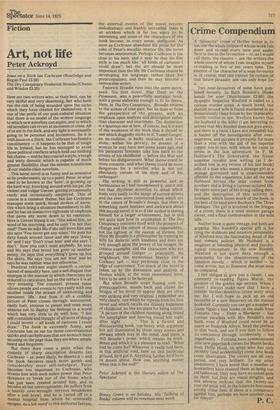Crime Compendium
A "favourite" crime or thriller writer is, to me, one the whole corpus of whose work I sit down and re-read every now and again. Next in line to the favourites — or, as I would call them, the classics — are the writers the whole oeuvre of whom I can imagine myself re-reading in five or ten years time. The essence of the character of a near-favourite is, of course, that one cannot be certain of that future pleasure: one can only hope for it.
Two near-favourites of mine have published recently. In Ruth Rendell's Shake hands for ever (Hutchinson £2.60) the dyspeptic Inspector Wexford is called to a curious murder scene. A much loved, but sluttish second wife is found murdered in an immaculately clean house by her implacably hostile mother-in-law. Wexford knows that the husband is the killer (I am betraying no secrets that Mrs Rendell does not give away, and there is a twist I have not revealed) but is hauled off the investigation after overeagerness, and pursues it privately for more than a year with the aid of his superior copper son-in-law, with whom he came to terms in the last adventure. In P. M. Hubbard's The Graveyard, the finest suspense novelist now writing (as I described him in my review of his last book) tells of a man who meets a strange girl in a strange graveyard and is unaccountably affected by the experience. Like all the best Hubbard heroes the man comes from nowhere and is living a curious isolated life. He earns some part of his living culling deer, and the description of this activity in Scotland, which forms much of the book, is the best of its kind since Buchan's The Three Hostages. The girl is involved in the fringes of a crime; there is a most sinister garage owner, and a final confrontation in the wild hills.
Neither book is quite vintage, but both are gripping. Mrs Rendell's special gift is for tying the stubborn and intuitive personality of Wexford into the fascinating detail of the best romans policier. Mr Hubbard is a magician at blending physical and psychological atmosphere. In the new Rendell, Wexford is not quite deep enough a personality for the obsessiveness of the Simenon novels — which is needed — to come across; but to Simenon she must now be compared.
I feel obliged to give you a classic. I am currently re-reading Ngaio Marsh, the greatest of the golden age writers. When I travel I always make sure that I have a reliable thriller/detective/crime story with me; but I still hope to pick up an old favourite or a new discovery on the station bookstall. Currently you can get a number of Dame Ngaio's best books on the stalls from Fontana. One — Enter a Murderer — has curious parallels with Mrs Rendell's new book, even if Wexford could never be as suave as Roderick Alleyn. Read the preface to that book, and see if you dare to follow its conclusion through. Incidentally — but importantly — Fontana have commissioned nine new paperback covers for Marsh books from Philip Hood, an artist who has only recently (and accidentally) come into book cover illustration. The covers are all very penod, and very brilliant. To my utter amazement I have heard that a number of booksellers have resisted them as being too old fashioned. They may have no naked girls on them, but they are visual delights, and this admirer reckons that the twenty-six year old artist will, in the future be honoured among crime fans. If there is a conspiracy against him, perhaps we have another case for Alleyn?
P. C.


























 Previous page
Previous page